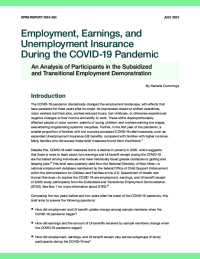Employment, Earnings, and Unemployment Insurance During the COVID-19 Pandemic
An Analysis of Participants in the Subsidized and Transitional Employment Demonstration

The COVID-19 pandemic dramatically changed the employment landscape, with effects that have persisted for three years after its onset. As businesses closed or shifted operations, many workers lost their jobs, worked reduced hours, lost childcare, or otherwise experienced negative changes to their income and ability to work. These shifts disproportionately affected people of color, women, parents of young children, and workers earning low wages, exacerbating longstanding systemic inequities. Further, in the first year of the pandemic, a smaller proportion of families with low incomes accessed COVID-19 relief measures, such as expanded Unemployment Insurance (UI) benefits, compared with families with higher incomes. Many families who did access these relief measures found them insufficient.
Despite this, COVID-19 relief measures led to a decline in poverty in 2020, which suggests that there is more to learn about how earnings and UI benefit receipt during the COVID-19 era fluctuated among individuals who have historically faced greater obstacles to getting and keeping jobs. This brief uses quarterly data from the National Directory of New Hires—a national employment database—to explore the COVID-19-era employment, earnings, and UI benefit receipt of 8,800 participants in the Subsidized and Transitional Employment Demonstration (STED).
Purpose
This brief explores how the COVID-19 pandemic shifted employment, earnings, and unemployment benefit receipt among workers who have historically faced obstacles to finding and keeping jobs in a more typical economic context—workers who were disproportionately affected by the pandemic. The brief focuses on experiences across geographic locations during the pandemic period, which may reflect differences in local economies, COVID-19 infection rates, and public policies. These results provide insight into how the government can support families during future public health and economic crises.
Primary Questions
- How did employment and UI benefit uptake change when the COVID-19 pandemic began?
- How did earnings and the amount of UI benefits received by sample members change when the COVID-19 pandemic began?
- How did COVID-19-era employment, earnings, and UI benefit receipt vary across subgroups of study participants?
Key Findings and Highlights
Overall, study participants experienced earnings setbacks during the pandemic period, and enhanced UI benefits helped stabilize their income. STED study participants experienced a dip in employment and earnings in the two-year period after the onset of COVID-19, but the dip was generally smaller than that seen in the general population. Employment and earnings mostly recovered to pre-pandemic levels by the first quarter of 2022, on average, but several sites were on a slight positive earnings trajectory in the period before the pandemic, and COVID-19 seems to have stalled earnings progress.
Most sites saw a large proportion of participants access enhanced UI programs, and the combination of formal earnings and UI benefits matched or slightly exceeded pre-pandemic earnings levels, on average. Across all sites, earnings had nearly or entirely rebounded to pre-pandemic levels during the second year of COVID-19. Across most sites, employment rates climbed steadily after reaching their nadir in the second and third quarters of 2020, suggesting that many study participants who had temporarily lost their jobs due to COVID-19 regained jobs within the period covered by the enhanced UI programs. In short, enhanced UI programs appear to have provided an essential safety net to many individuals whose jobs were lost and whose employment prospects were unpredictable or nonexistent.
Methods
This brief uses quarterly data from the National Directory of New Hires—a national employment database—to explore the COVID-19-era employment, earnings, and UI benefit receipt of 8,800 participants in STED. To investigate the relationship between COVID-19, employment, and UI benefit receipt, this analysis examines how employment rates, average earnings, and UI benefit receipt changed when the pandemic became widespread in the United States at the end of the first quarter of 2020. To account for seasonal and annual variation, as well as the way the employment landscape shifted throughout the pandemic, this analysis looks across the two years before and the two years after COVID-19 became widespread.
Document Details
Cummings, Danielle. 2023. “Employment, Earnings, and Unemployment Insurance During the COVID-19 Pandemic: An Analysis of Participants in the Subsidized and Transitional Employment Demonstration.” OPRE Report 2023-00. Washington, DC: Office of Planning, Research, and Evaluation, Administration for Children and Families, U.S. Department of Health and Human Services.






